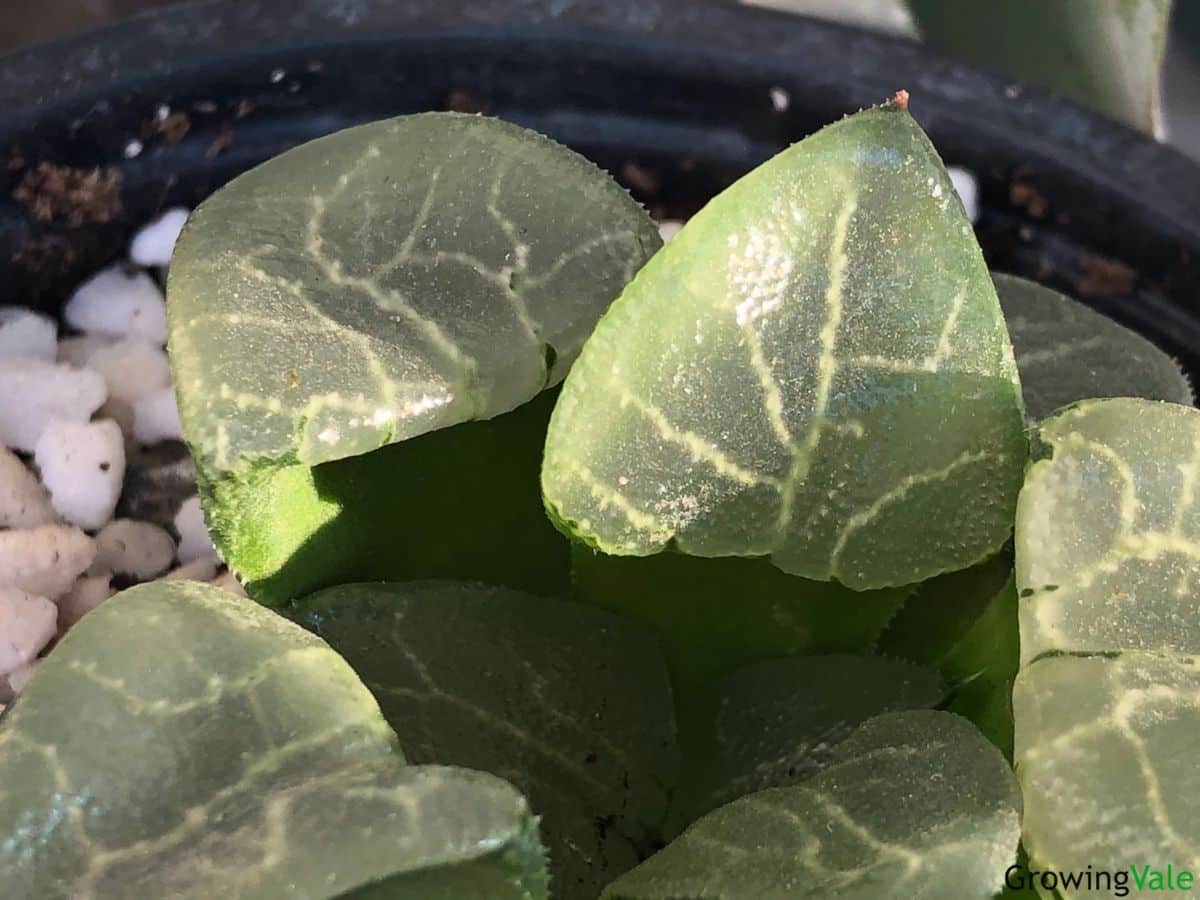A healthy Haworthia cooperi rosette can be quite fascinating as it is unique in the plant world. Its delicate leaves look as though they are inflated with water. They are somewhat translucent, smooth to the touch, and can have a shiny luster. This is why the species is sometimes likened to a clump of pearls.
Remarkably small yet eye-catching, H. cooperi grows to a maximum height of just 4 inches. The perky leaves appear to jut out of the ground, as though a shoot is fully absent. This tiny plant can be a charming desk companion for those late nights at the office. It simply has to be lifted up to the light to reveal its amazing features.
History
Haworthia cooperi is endemic to South Africa, particularly the Eastern Cape Province. There, its rosettes arise in clumps that settle in between the rough features of cliff faces. This slow-growing succulent is a collector’s favorite and comes in many varieties. It is now a staple addition to conservatories and botanical gardens all over the world.
This species is fondly called cushion aloe, Cooper’s haworthia, or window haworthia. Its scientific epithet is attributed to James Graham Cooper, who contributed greatly to records of American natural history.
Plant Facts
| Scientific name | Haworthia cooperi |
| Common names | Cushion Aloe, Window Haworthia, Cooper’s Haworthia |
| Genus | Haworthia |
| Family | Asphodelaceae |
| Height | 2 inches (average) |
| Width | 4 inches |
| USDA Plant Hardiness Zone | 9-10 |
| Origin | South Africa |
| Flower colors | White |
| Blooming season | Summer |
| Plant/Flower special features | Translucent foliage |
How to Plant and Grow Haworthia cooperi
H. cooperi can be grown via seed or plant division, with the use of its offsets. Seed growth can be quite challenging and is often left to the experts. Offset establishment is far easier and will simply require basic materials for propagation.
To ensure that its rosettes are able to thrive, they should be planted in small pots that can comfortably accommodate the root system and width of the plant. Pots that are too large can prevent the rapid evaporation of moisture. Good drainage, controlled humidity, and proper light exposure are key to ensuring rapid growth. When conditions are optimal, mature rosettes will produce long flower stalks with inconspicuous white blooms in summer.
How to Propagate Haworthia cooperi
Fully dig out the entire plant, making sure to keep its roots intact. Offsets that are at least about an inch in width should be separated from the base of the rosette. They should already have their own root systems. Place these in their own pots of freshly prepared soil, with the root base situated about 0.5 cm below the soil surface.
Care and Maintenance
Here’s what to know when it comes to Haworthia care:
Soil
Haworthia cooperi should be planted in a well-draining soil mix that can facilitate the rapid loss of moisture. A cacti or succulent mix should suffice.
If you are only able to acquire a conventional houseplant mix or garden soil, it will have to be mixed with other components to increase its porousness. A mixture with pumice or perlite, sand, gravel, and stones should suffice.
Water
Provide the pot with water only when the top few inches of soil have completely dried out. You can check for moisture by dipping your finger into the soil. If the soil still feels moist, delay the next watering session.
Fertilizer
Haworthia cooperi can thrive in poor soils and will not need additional fertilizer. If you feel the need to condition your soil after the plant has become fully established, you can make use of a low concentration fertilizer. This should be applied simultaneously with water.
Sunlight
Filtered or partial sunlight is best for this plant. Exposure to full sun can cause its leaves to scorch or shrivel up.
Temperature and Humidity
A temperature range of 15-35C is preferable. High humidity is undesirable but can be tolerated by this species.
Pruning
Rosettes will not need to be pruned as they are low-growing. Spent flower stalks should be cut down at the end of each bloom period.
Repotting and Transplanting
Haworthia cooperi should be repotted once every 2-3 years.
Pests and Diseases
This species should be resistant to pests and diseases as long as it is reared in proper conditions. Plants that are infested with pests should be kept away from H. cooperi rosettes to prevent contamination.
Uses of Haworthia cooperi
This plant is chiefly used for ornamental purposes and as a miniature desk companion.
Common Varieties
These Haworthia types tend to vary based on their leaf shape, texture, degree of translucence, and color patterns.
- H. cooperi var. tenera
- H. cooperi var. truncata
- H. cooperi var. venusta
- H. cooperi var. pilifera
- H. cooperi var. leightonii
Conclusion
Haworthia cooperi is a miniature plant that requires minimal care and attention. Collectors favor this species for its many variations, but most of all for its incredible foliage.

